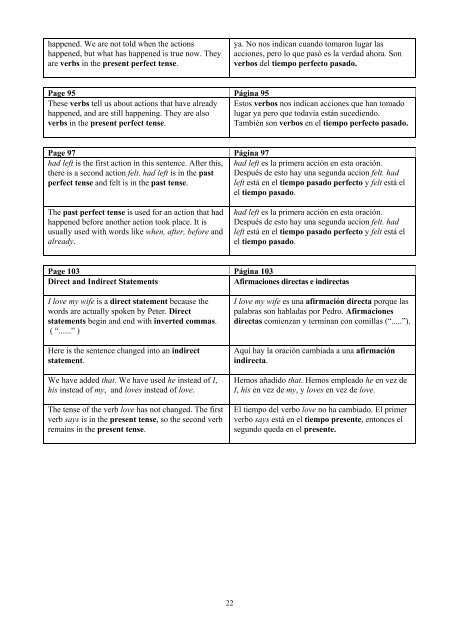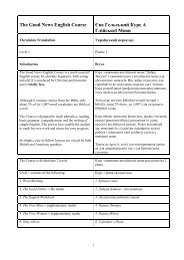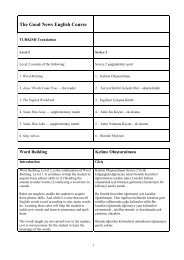The Good News English Course El Curso de Inglés âLas Buenas ...
The Good News English Course El Curso de Inglés âLas Buenas ...
The Good News English Course El Curso de Inglés âLas Buenas ...
Create successful ePaper yourself
Turn your PDF publications into a flip-book with our unique Google optimized e-Paper software.
happened. We are not told when the actions<br />
happened, but what has happened is true now. <strong>The</strong>y<br />
are verbs in the present perfect tense.<br />
ya. No nos indican cuando tomaron lugar las<br />
acciones, pero lo que pasó es la verdad ahora. Son<br />
verbos <strong>de</strong>l tiempo perfecto pasado.<br />
Page 95 Página 95<br />
<strong>The</strong>se verbs tell us about actions that have already Estos verbos nos indican acciones que han tomado<br />
happened, and are still happening. <strong>The</strong>y are also lugar ya pero que todavía están sucediendo.<br />
verbs in the present perfect tense.<br />
También son verbos en el tiempo perfecto pasado.<br />
Page 97 Página 97<br />
had left is the first action in this sentence. After this, had left es la primera acción en esta oración.<br />
there is a second action felt. had left is in the past Después <strong>de</strong> esto hay una segunda accion felt. had<br />
perfect tense and felt is in the past tense.<br />
left está en el tiempo pasado perfecto y felt está el<br />
el tiempo pasado.<br />
<strong>The</strong> past perfect tense is used for an action that had<br />
happened before another action took place. It is<br />
usually used with words like when, after, before and<br />
already.<br />
had left es la primera acción en esta oración.<br />
Después <strong>de</strong> esto hay una segunda accion felt. had<br />
left está en el tiempo pasado perfecto y felt está el<br />
el tiempo pasado.<br />
Page 103 Página 103<br />
Direct and Indirect Statements<br />
Afirmaciones directas e indirectas<br />
I love my wife is a direct statement because the<br />
words are actually spoken by Peter. Direct<br />
statements begin and end with inverted commas.<br />
( “......” )<br />
Here is the sentence changed into an indirect<br />
statement.<br />
We have ad<strong>de</strong>d that. We have used he instead of I,<br />
his instead of my, and loves instead of love.<br />
<strong>The</strong> tense of the verb love has not changed. <strong>The</strong> first<br />
verb says is in the present tense, so the second verb<br />
remains in the present tense.<br />
I love my wife es una afirmación directa porque las<br />
palabras son habladas por Pedro. Afirmaciones<br />
directas comienzan y terminan con comillas (“.....”).<br />
Aquí hay la oración cambiada a una afirmación<br />
indirecta.<br />
Hemos añadido that. Hemos empleado he en vez <strong>de</strong><br />
I, his en vez <strong>de</strong> my, y loves en vez <strong>de</strong> love.<br />
<strong>El</strong> tiempo <strong>de</strong>l verbo love no ha cambiado. <strong>El</strong> primer<br />
verbo says está en el tiempo presente, entonces el<br />
segundo queda en el presente.<br />
22





